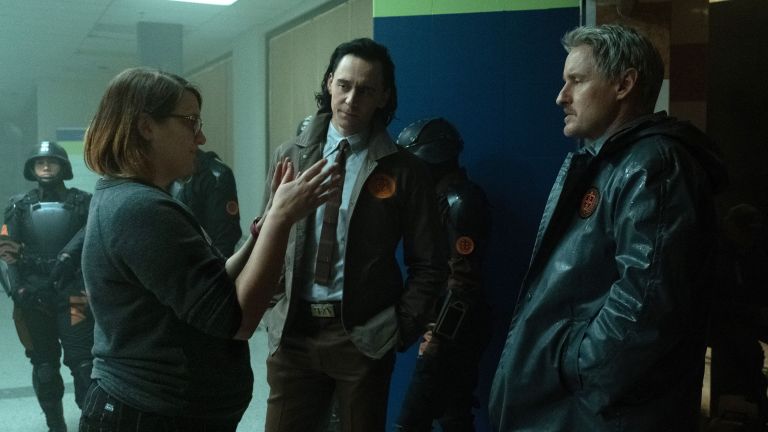How Marvel’s New TV Model Worked on Loki
The Disney+ Marvel TV shows are operating without a showrunner. We talked to Loki director Kate Herron about what that looks like.

This Loki article contains some spoilers.
We talk a lot about how the line between what constitutes a TV show and what constitutes a movie has become increasingly blurred in this era of fractured entertainment and diverse distribution models. While the last decade has seen TV shows incorporating more cinematic elements into their production structure, the traditional TV showrunner model has mostly stayed fixed, representing a major difference in how TV is made versus how film is made.
For those who don’t know, a showrunner is the lead executive producer of a series, which means they have both creative and managerial control of a TV series’ production. Because of this, TV is known as a writer’s medium, while film is known as a director’s medium. In the Disney+ era, Marvel Studios is eschewing the showrunner model for something much more cinematically minded. In this Marvel TV model, there is a head writer rather than a showrunner, and the director has much more creative control.
“The best way I can explain how we worked was that [head writer] Michael [Waldron] was on with us until he got stolen by Doctor Strange [and the Multiverse of Madness],” says Loki director Kate Herron, when asked for her perspective on working within this non-traditional TV model. “And then Eric [Martin] was our production writer.”
Waldron left after completing the writers’ room for Loki in order to work on the script for the Doctor Strange sequel. In a showrunner model, this would have been a much bigger deal, as the showrunner’s role expands beyond just making sure all of the episodes are written to elements like ensuring production stays on budget and approving final cuts of episodes.
In the traditional American TV model (it’s worth noting that the showrunner model is less common in the U.K., which can give the director more of an impact on the creative vision of a TV show), directors have much less creative control; they are hired hands brought in to shoot the script for an individual episode before moving on to another show. This isn’t the case with Loki and other Disney+ Marvel TV shows, where the directors are empowered to make more of the creative decisions, though the ultimate authority seems to lie with Marvel Chief Creative Officer Kevin Feige, the mastermind behind the MCU.
“We generally ran it like a movie,” continues Herron. “I worked with the writers in pre-production and we worked on story, and then across the shoot in the edit. It was me working with the studio and the cuts.”
Waldron ran a traditional writers’ room that produced “some very amazing scripts,” says Herron. Upon her arrival, Herron teamed up with Waldron, Martin, executive producer Kevin Wright, and visualization coordinator Alyssa Knittel to further shepherd the story.
“There was a few story elements that we worked on there, like the TVA all being variants and [other] bits and pieces across the show,” says Herron of this part in the pre-production process.
When asked if the production model made Herron more interested in the job, the British director says: “I wanted to work with Marvel, and I didn’t know they were doing [a different TV model], to be honest, until I pitched. I love Loki, so I just was like, ‘I’m going to see if I can be involved somehow.'”
While Herron says the non-traditional TV model wasn’t a factor in pitching for the director gig on Loki, it was something that excited her as both a writer and director. “After Sex Education,” says Herron, “I was like, ‘You know, I really want to make a movie, and I’m also a writer.’ So [Loki] definitely was a very different way to approach television, which felt very interesting to me.”
While Herron won’t be returning for Loki Season 2 she’s very happy with how Season 1 turned out. When asked if there was a particularly hard scene or storyline to leave on the cutting room floor, she can’t think of anything.
“To be honest, I don’t think so,” says Herron. “I’m so happy with the edits we had. There are, of course, some moments that you have to remove, but I think everything we took out, even though some of it was good, it’s just, tonally, it wasn’t right for the story. And I do think the story we put out into the world is the best version of the story we wanted to tell.”
